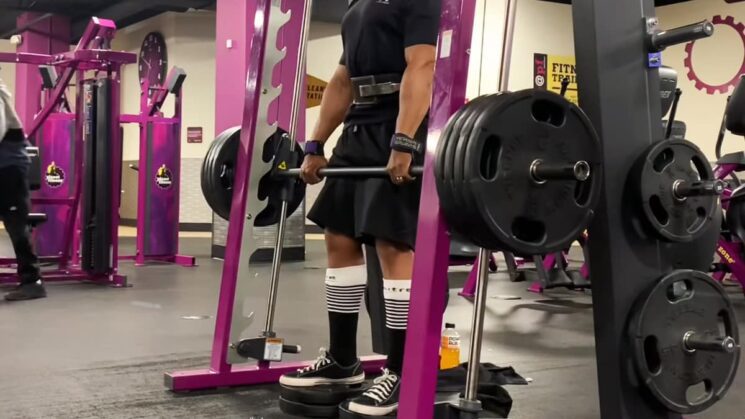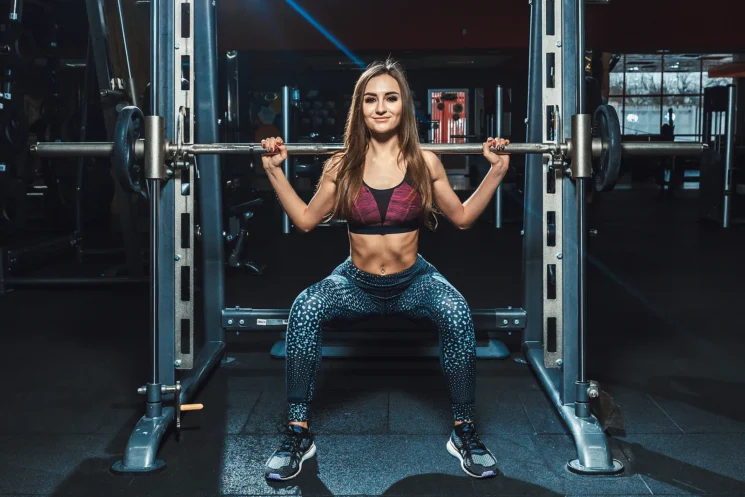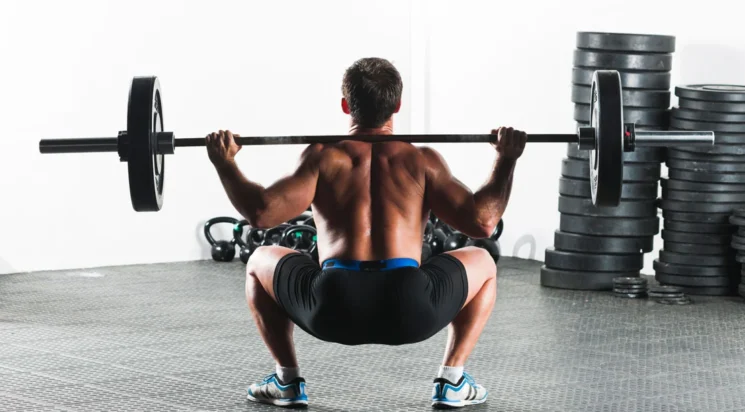Ready to learn the best technique and tips on how to deadlift on a Smith machine? Well, you’ve come to the right place. In this blog post, we’ll go over everything you need to know so that you can get the most out of your workout and achieve your fitness goals safely. So, grab your workout shoes and let’s get ready to move some iron!
In This Post
Setting Up for the Deadlift

When setting up for the deadlift on a machine it is important to remember that each body is different and the technique used needs to be catered to each individual. Before getting started, it is important to have the correct form and technique by following these steps:
- Begin with your feet set shoulder width apart and slightly angled outwards, with your toes slightly pointed out. Make sure your weight is distributed evenly between both feet.
- Take a hip-width grip on the barbell just outside of shoulder-width, then bend at your hips and knees so that you are in a partial squat position with your chest up and shoulders back.
- Maintaining this chest up, shoulder back posture; use an explosive hip drive to launch yourself from the bottom position towards locking out of the movement at the top of the deadlift. All throughout this movement ensure that you keep your shoulders tight and braced, with no rounding or excessive arching in both upper and lower back positions.
- Finally, when returning back down into your starting position be sure to always maintain control, lowering at a consistent pace until you have returned fully into your original bottom-position ready for another repetition.
Technique Tips for Deadlifting on a Smith Machine

When performing the deadlift on a Smith machine, it’s important to pay attention to technique and safety. Here are some of the key tips for performing the movement correctly:
- Ensure Your Feet are Planted Firmly and Evenly on the Floor: When setting up in your starting position, make sure that you have your feet firmly planted evenly on the floor beside each other. This creates a stable base that will further ensure correct execution and provide a solid foundation from which you can lift correctly.
- Sit Back at the Start Position: At this position, you should be selectively sitting back into the lift. You should be sitting down in an arched back fashion, with your chest held high at the start position of every rep. This allows for greater activation of posterior chain muscles which is vital for strength and power production during this exercise.
- Keep Your Weight Through Your Heels: Throughout each repetition, focus on keeping as much weight through your heels as possible in order to promote hips extension throughout each rep – leading to better balance and superior gluteal muscle activation when compared to deadlifting with a traditional barbell setup or with dumbbells.
- Drive Through Your Hips From Setup to Lock-Out Position: Once you’re ready to drive up through your setup, drive through your hips all of the way up until you’ve reached full lock-out position – do not lock out by hyperextending down onto your toes! This allows for better body posture during the movement as well as direct engagement by agonist muscles throughout range-of-motion instead of relying wholly upon momentum created from extended spine (inadequate lever-length).
- Repeat Properly Formed Reps During Each Set: After lockout has been reached following each effective repetition, lower self under control back down towards starting/setup position – when done properly there will be no bounce involved! Note any type of bouncing affected during this exercise is undesired as it increases chance of muscular recoil injuries along with causing harm to specific tissue areas not activated during any contractile motion (i.e., lumbar erector spinae attachment points).
One exercise that works the back of the shoulder and is a common gym exercise used to strengthen these muscles and have a similar effect like deadlift is the rear delt cable fly. This exercise can be done using resistance bands, barbells, or with a smith machine.
Common Mistakes to Avoid

When performing a deadlift on these machines, there are several common mistakes that can prevent you from getting the most out of your exercise and can even lead to injury. To safely and effectively perform this exercise, it is important to understand and avoid these mistakes.
One mistake that is often made when deadlifting on a Smith machine is attempting too much weight. Many people may attempt to lift more than they are physically capable of and this can result in potentially serious injury. It is important to use a weight that allows you to maintain proper form throughout the entire range of motion for each repetition.
Another mistake when using the Smith machine for deadlifts is not setting up properly. Having correct posture throughout the movement will help ensure proper form and reduce the risk of injury. This means maintaining a neutral back position before starting each rep, engaging your core muscles throughout, keeping your shoulders back as you lift off from the floor, and standing tall at the finish position instead of bending over or rounding forward.
Incorrect grip placement on the barbell can also affect performance during Smith machine deadlifts. If possible, it is best to grab onto both sides of the bar just outside shoulder width with fingers wrapped around it instead of holding hands under it in a traditional style deadlift grip. This will help keep your torso upright throughout each rep so that more stress is placed on working muscles rather than on hinging at all times at hips/spine while lifting off from floor position which places load onto lower back unnecessarily.
Conclusion
Deadlifting on it requires a bit of skill and knowledge to use safely and effectively. Nailing the basics of form, posture, gripping the barbell, and setting out an appropriate lifting plan is crucial for safe lifting. Additionally, each rep should be done with intention, focusing on perfecting your form by using full range of motion and hinging from your hips.
The Smith machine deadlift is not a modified version of the traditional deadlift; it’s an entirely different movement and should be respected as such. Therefore, taking time to learn proper technique in order to get the maximum benefit is essential when engaging in this exercise. Ultimately, if you practice perfectly every time you’ll gradually develop strength, improved balance and flexibility.